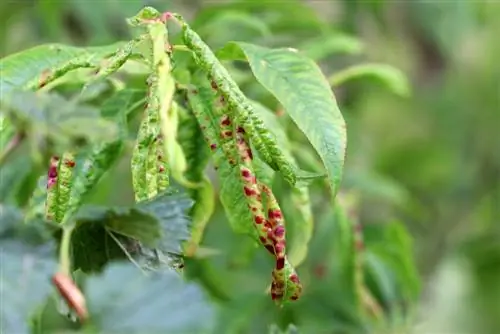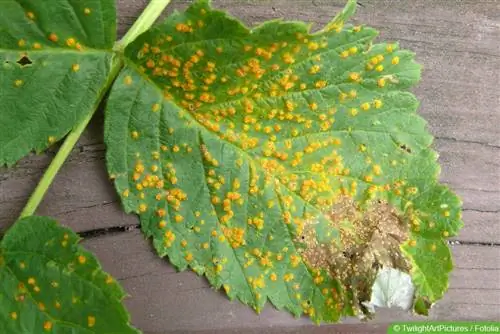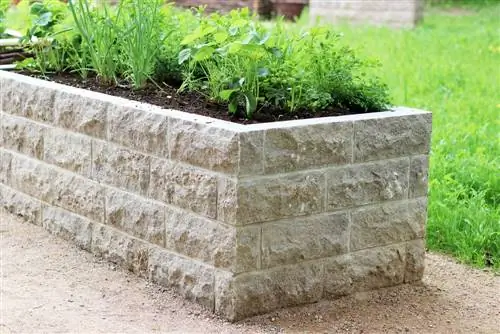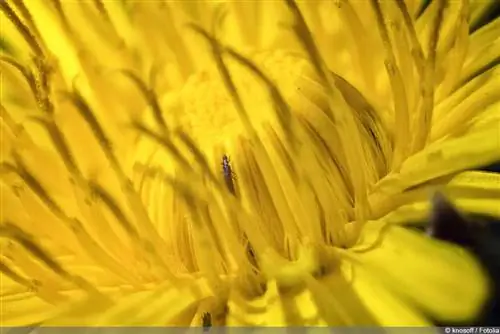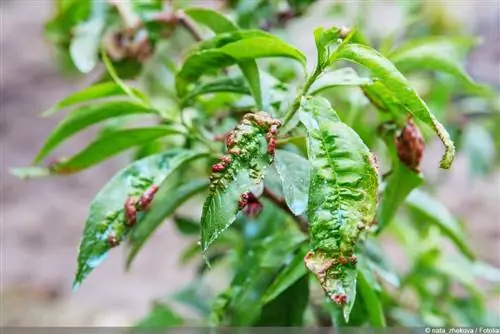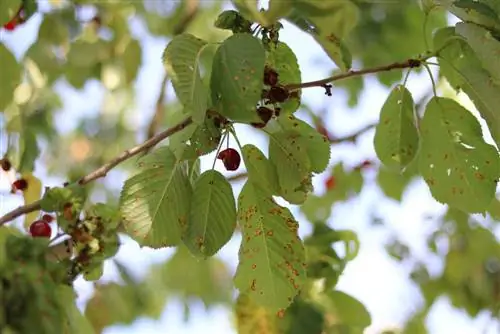- Author admin [email protected].
- Public 2023-12-17 03:39.
- Last modified 2025-01-24 12:45.
Curled, misshapen leaves on peach, apricot, nectarine or almond trees are an unmistakable sign of curl disease. It occurs in spring, immediately after the first shoots. The disease doesn't just result in an unsightly appearance. It can lead to complete loss of leaves, weakening of the tree and reduction in harvest. How to prevent the disease? We present effective home remedies.
The frizz disease
The curl or blister disease occurs on peach, apricot, nectarine and almond trees. The cause of the disease is the ascomycete fungus Taphrina deformans. The first symptoms appear in spring.
malicious image
- Leaves are heavily curled after sprouting
- initially blistering, later white to reddish discoloration of the leaf surfaces
- Thickening and deformation of the young leaves
- affected areas become glassy
- Leaf tissue becomes brittle
- Leaves fall off
- Fruit production reduced
- Fruits increasingly fall off
- Disturbance of bud formation in the following year
- reduced growth
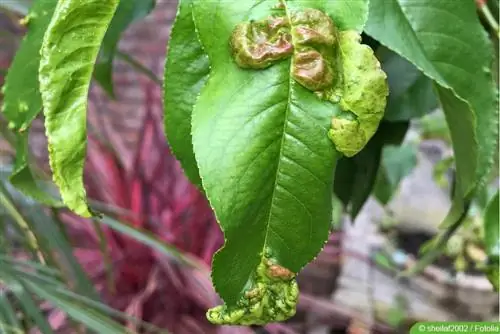
In cases of severe fungal infestation, individual shoots die completely. Young trees in particular can be weakened so much that they no longer recover and have to be cleared. The risk of fungal infection is highest during the bud swelling period. For some varieties it starts at the end of January. Only when the outside temperatures consistently rise above 16 degrees Celsius is the risk of infection averted.
Prevention and Control
There are various ways to successfully combat the frizz disease.
Choice of varieties
If you want to plant a peach tree, you should prefer varieties that have low susceptibility. White and red-fleshed varieties are less likely to be affected by the fungus Taphrina deformans than those with yellow flesh.
Proven varieties are:
- Amsden
- Benedict
- Fidelio
- Former Alexander
- Red Ellerstädter
- Red Vineyard Peach
Suitable location
In addition to choosing a robust variety, the location has a decisive influence on plant growth and harvest success. Above all, it should be airy, sunny and protected from rain. Moisture promotes fungal infestation. Small varieties can be protected from the disease in the pot. In a location under a roof, the tree is protected from precipitation and the fungus does not find suitable conditions. As soon as it gets warmer, the potted plant can be moved to a sunny location outdoors. Hanging foil over the top in winter and spring until the outside temperature reaches 16 degrees Celsius also helps against fungal infestation.
Underplantings
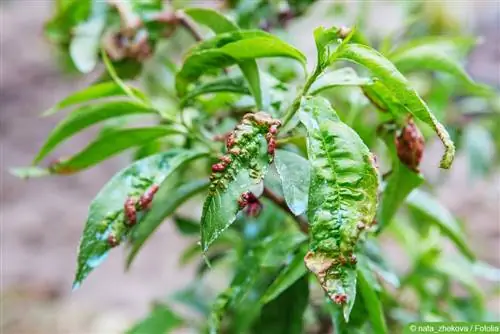
Organic gardening not only means avoiding chemicals, but also choosing plant partnerships carefully. Plants in the neighborhood influence each other. To prevent fungal diseases such as bladder disease, underplanting fruit trees with garlic and nasturtium has proven to be effective.
Blending
Trees with heavily branched, dense branches offer good conditions for fungal diseases. For this reason, we recommend pruning peach trees and other types of fruit annually. After rainfall, the branches can dry out quickly and are well protected from fungal infestation.
Inject plant strengtheners
If temperatures rise above 10 degrees Celsius, you can strengthen the peach tree with herbal remedies and prevent diseases organically.
Garlic Extract
- Crush 50 grams of garlic
- pour a liter of boiling water over it
- Let it steep for 30 minutes.
- pour through a sieve
- let it cool down
- inject undiluted every two to three weeks
Field horsetail broth
- Crush 150 grams of fresh field horsetail
- soak in water overnight
- simmer gently for one hour
- pour through a sieve
- let it cool down
- diluted with five parts water, spray several times every two weeks
Tree protection with lime milk
Painting with milk of lime has been used for generations to protect fruit tree bark from frost and disease. It is easy to make, keeps the bark elastic and he althy and helps ward off Taphrina deformans.
- Mix water with lime until you get a milk-like consistency
- add a splash of detergent
- Apply lime milk several times a year
Spraying with vinegar
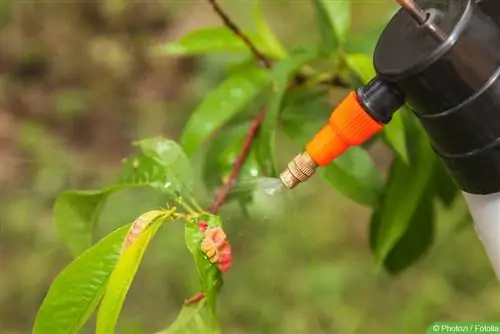
As well as in the home, vinegar can also be useful in the garden. It helps destroy weeds, eliminate pests and is used as a spray to prevent fungal diseases.
- Mix 10 percent vinegar or apple cider vinegar with a splash of dish soap
- Put in a spray bottle and spray undiluted from September to November
- do not use in conjunction with lime milk
Attention:
The vinegar spray should only be used to prevent curl disease in autumn. Spraying in spring is too late and can damage leaves, buds and fruits.
Fertilize
Appropriate fertilization is considered an effective measure to strengthen the tree. Trees that are already diseased should also be strengthened with the help of fertilization in order to compensate for the weakening caused by leaf loss caused by the disease. The loss of leaves leads to less food intake and causes enormous damage to the peach tree.
Tip:
Keep the tree disc free of weeds. Add compost and cover the tree disc with mulch.
Destroy affected leaves and shoots
Collect the fallen leaves and remove infected shoot tips. You can burn the affected plant parts or dispose of them with household waste. Under no circumstances should leaves and shoots affected by curl disease be placed in the compost! The thorough destruction leads to a significant reduction of the pathogen and determines success.

